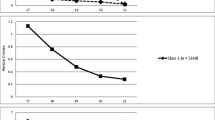Abstract
In this paper we address whether there are distinctive differences in the processes determining participation in offending vs frequency of offending. We develop a number of tests to examine not only whether the correlates of participation and frequency are similar but also whether the same underlying statistical model is consistent with the data on both these dimensions of a criminal career. The tests are applied using data from the first two waves of the National Youth Survey. While the findings are not without ambiguities, they do not support the idea that distinguishing among the dimensions of a criminal career is a fundamental requirement for conducting sound research on the causes of crime and delinquency.
Similar content being viewed by others
References
Blumstein, A. and Graddy, E. (1982). Prevalence and recidivism in index arrests: A feedback model.Law Society Rev. 16: 265–290.
Blumstein, A., Cohen, J., and Nagin, D. (1979).Deterrence and Incapacitation: Estimating the Effects of Criminal Sanctions on Crime. Report of the Panel on Research on Deterrent and Incapacitative Effects, National Academy Press, Washington, D.C.
Blumstein, A., Cohen, J., Roth, J., and Visher, C. A. (1986).Criminal Careers and “Career Criminals,” National Academy Press, Washington, D.C.
Blumstein, A., Cohen, J., and Farrington, D. (1988). Criminal career research: Its value for criminology.Criminology 26: 1–35.
Chaiken, J., and Chaiken, M. (1982).Varieties of Criminal Behavior, Rand, Santa Monica, Calif.
Elliott, D., Knowles, S., and Canter, R. (1981). The Epidemiology of Delinquent Behavior and Drug Use Among American Adolescents. Project Report 14 from The Dynamics of Delinquent Behavior: A National Survey, Behavioral Research Institute, Boulder, Colo.
Elliott, D., Huizinga, D., and Ageton, S. (1982).Delinquency and Drug Use, Sage, Beverly Hills, Calif.
Elliott, D., Menard, S., and Huizinga, D. (1989).Multiple Problem Youth, Springer Verlag, New York.
Gottfredson, M. R., and Hirschi, T. (1986). The true value of lambda would appear to be zero: An essay on career criminals, criminal careers, selective incapacitation, cohort studies, and related topics.Criminology 24: 213–233.
Gottfredson, M. R., and Hirschi, T. (1988). Science, public policy, and the career paradigm.Criminology 26: 37–56.
Hechman, J. J. (1980). Sample selection bias as a specification error with an application to the estimation of labor supply function. In Smith, J. P. (ed.),Female Labor Supply, Princeton University Press, Princeton, N.J.
Hechman, J. J. (1981a). Heterogeneity and state dependence. In Rose, S. (ed.),Studies in Labor Markets, University of Chicago Press, Chicago.
Hechman, J. J. (1981b). Statistical models for discrete panel data. In Manski, C., and McFadden, D. (eds.),The Structural Analysis of Discrete Data, MIT Press, Cambridge, Mass.
Hechman, J. J. (1981c). The incidental parameters problem and the problem of initial conditions in estimating a discrete time-discrete data stochastic process. In Manski, C., and McFadden, D. (eds.),The Structural Analysis of Discrete Data, MIT Press, Cambridge, Mass.
Maddala, G. S. (1983).Limited Dependent and Qualitative Variables in Econometrics, Cambridge University Press, New York.
Maddala, G. S. (1984). Limited dependent variable models using panel data.J. Hum. Resources 22: 307–338.
Manski, C. (1989). The anatomy of the selection problem.J. Hum. Resources 24: 343–360.
Paternoster, R., and Triplett, R. (1988). Disaggregating self-reported delinquency and its implications for theory.Criminology 26: 591–620.
Smith, D. A., Visher, C. A., and Jarjoura, G. R. (1990). Dimensions of delinquency: Estimating the correlates of participation, frequency, and persistence of delinquent behavior.J. Crime Delinq. (in press).
Wolfgang, M., Figlio, R., and Sellin, T. (1972).Delinquency in a Birth Cohort, University of Chicago Press, Chicago.
Author information
Authors and Affiliations
Rights and permissions
About this article
Cite this article
Nagin, D.S., Smith, D.A. Participation in and frequency of delinquent behavior: A test for structural differences. J Quant Criminol 6, 335–356 (1990). https://doi.org/10.1007/BF01066675
Issue Date:
DOI: https://doi.org/10.1007/BF01066675



